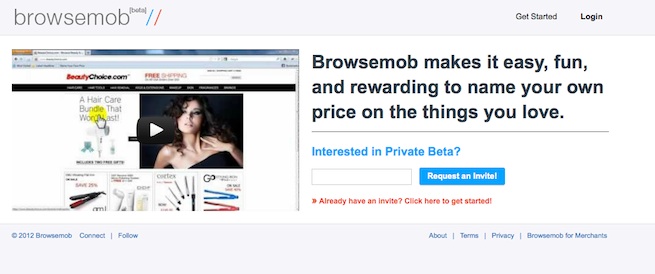Editor’s note: This is the first in a series of VentureBeat columns by award-winning author and serial entrepreneur Penelope Trunk. She’s going to be our startup critic: She’ll review new companies, point out what they’re doing right, and give them advice (which she’s never shy about anyway) for how they can improve. Her first company is Browsemob.
Browsemob is a site that lets you tell a retailer what you’d be willing to pay for an item they sell.
If you go to Browsemob’s site, the first thing you see is a photo of a woman who looks excited in a touching-herself way.
So look, this is the first sign that there is no one on the management team who knows about marketing. Because in any book about body language, a woman touching herself means, “I want you.”
The “I want you” picture, together with the name Browsemob, makes the site look like it’s a matching site for hot women and the unruly mobs of boys who want to hire those women for something that will turn out badly, like a Duke lacrosse party.
It’s just not good.
But I give the site the benefit of doubt, because it’s about the customer setting the price. I like this because I do tons of coaching and I’m always trying to figure out the right price. I charge $250 for an hour and I get annoyed when I am coaching a millionaire, because I think I should have added a few more zeros. But I also feel bad when I price myself too high for struggling college students. Those are fun people to coach. I am excited for Browsemob to show me how to price my own services.
The problem is that Browsemob is about economics. The founders have identified an inefficiency in the marketplace: There are, I don’t know, ten days when a retailer knows they will discount a product but they have not yet done so. During that window, there is a possibility to sell the product at a smaller discount.
There is a lot of math involved in figuring out this inefficiency and optimizing it. But the bottom line is that there is a ton of inefficiency in the world that is not worth confronting, and this is unfortunately an example.
Matt Hurewitz, a founder of Browsemob, is really nice. He lets me cut him off four hundred times. Every time he tells me about the economics I tell him that I’m sure the economics are right. I’m sold. No one is solving the problem he’s talking about and he can solve it. I got it.
I want to know: Can he get any large retailer to care enough about this market inefficiency enough to sign up for his site?
No. The answer is no. He only has this beauty product company that is masquerading as a sex shop on his home page. This will not propel his company to success.
You need a big retailer to succeed, I tell him.
He says he knows.
I say, no retailer will care enough about the problem you are proposing to solve. What did the Gap say?
He says that the Gap said that integration with Browsemob would need to be very sophisticated and…
Wait. What?
He repeats the word “sophisticated,” and I repeat to him that there is no way anyone is going to take the time to make changes in their discounting system in order to save a minuscule amount of money for their company.
This is how our conversation goes: I am obnoxious and impatient. He is nice and sweet. This reminds me that math guys are not good at pitching companies, but they are very good for dating. They are patient and honest. Good qualities. But I digress, and anyway, if you are wondering, he’s married. So we are back to the company.
The code is already written. A lot of it. I want to tell you something: Don’t do this. Don’t write code before you know what you’re going to use it for. This company is a perfect example.
Obviously there is a market inefficiency in discounting systems. There is money left on the table. It’s up to Matt to show that companies actually care that he can solve this problem.
So, before he writes all the code to solve the problem, he should go to a company and get them to sign up. He can give them a demo that sort of works but only takes about ten minutes to code, in HTML. The prospective customer won’t care, because they are making a business decision, not a coding decision. Once he has got a company signed up, then he can start coding to solve the real customer’s real problem.
You need to look at your startup idea. If the hardest part of the business is showing that the code can work, then you need to write the code first. For instance, if you are trying to allow ten billion people to tweet simultaneously, you’re not going to get very far unless you have already written code that makes that possible. But in most cases, people believe you can write the code and the hardest part of the business is something else. Do that hardest thing first, before you spend time writing the code.
In this case, Matt should cut a deal. Get a company to sign a letter of intent to use the software to unload almost-on-sale items. Then he has reason to believe it’s worth building the software.
Another thing: Don’t pitch for news coverage if you can’t use it. Save PR for when you need more customers or when you need investors. Right now, all Browsemob needs is someone from a large retailer who cares about the problem they are solving. What it needs is to close a sale.
Matt did say something interesting, though. He said he got the idea for this company from his friend who asks for a discount everywhere. He said his friend gets discounts almost every time, at least a few dollars, from stores of all sizes
I say the friend is totally annoying.
Matt says he knows. But maybe this site can give everyone the ability to ask for those discounts without being annoying. That’s a good vision: It’s fun, and it promises something good in the end. I don’t think he’s really on the right path yet, but really, all startups are about pivots, so in case he pivots to the point where you can haggle with impunity, you can sign up here: www.browsemob.com/signup.
 Penelope Trunk founded Brazen Careerist and two other startups. Her career advice runs in 200 newspapers, and she is the author of a bestselling career advice book. She lives on a farm in Wisconsin and homeschools her sons.
Penelope Trunk founded Brazen Careerist and two other startups. Her career advice runs in 200 newspapers, and she is the author of a bestselling career advice book. She lives on a farm in Wisconsin and homeschools her sons.
Nurse thumbnail image via ShutterStock
VentureBeat's mission is to be a digital town square for technical decision-makers to gain knowledge about transformative enterprise technology and transact. Learn More


